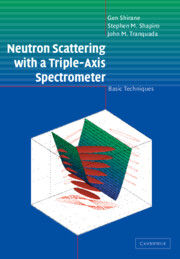Book contents
- Frontmatter
- Contents
- Preface
- 1 Introduction
- 2 Scattering formulas
- 3 Elements of a three-axis instrument
- 4 Inelastic scattering and the resolution function
- 5 Phonons and magnons
- 6 Spurious peaks
- 7 Bragg diffraction
- 8 Polarized neutrons
- Appendix 1 Neutron scattering lengths and cross sections
- Appendix 2 Crystallographic data
- Appendix 3 Other useful tables
- Appendix 4 The resolution function for a triple-axis neutron spectrometer
- Index
4 - Inelastic scattering and the resolution function
Published online by Cambridge University Press: 19 August 2009
- Frontmatter
- Contents
- Preface
- 1 Introduction
- 2 Scattering formulas
- 3 Elements of a three-axis instrument
- 4 Inelastic scattering and the resolution function
- 5 Phonons and magnons
- 6 Spurious peaks
- 7 Bragg diffraction
- 8 Polarized neutrons
- Appendix 1 Neutron scattering lengths and cross sections
- Appendix 2 Crystallographic data
- Appendix 3 Other useful tables
- Appendix 4 The resolution function for a triple-axis neutron spectrometer
- Index
Summary
One of the chief strengths of the triple-axis spectrometer is its ability to measure the intensity of scattered neutrons for a particular momentum transfer Q0 and energy transfer ħω0. This capability is especially important for measurements of inelastic scattering from single crystals. With a computer-controlled spectrometer, it is a simple matter to scan the energy transfer while sitting at a specific point in reciprocal space. Conversely, one may choose to scan the spectrometer along a particular direction in reciprocal space while maintaining a constant energy transfer. Such scans are easily interpreted, both qualitatively and quantitatively, as we will discuss.
Of course, because of the small scattering cross section for neutrons and the limited neutron flux generally available, one must typically perform measurements with finite beam divergences and with monochromator and analyzer crystals having significant mosaic widths. As a result, the energy and momentum transfers of the neutrons are distributed within some small region about the average values (ω0, Q0). It is possible to describe the measured signal as a convolution of a spectrometer resolution function R(Q–Q0, ω–ω0) and the scattering function S(Q, ω). The resolution function is peaked at (ω0, Q0) and decreases for deviations (Δω, ΔQ). The constant-amplitude contours for the resolution function form a set of nested ellipsoids in (ω, Q) space and, for a given spectrometer configuration, the volume, shape, and orientation of these ellipsoids depend only on (ω0, Q0). The form of the measured spectra will depend on the way in which the resolution function is scanned through the structures defined by the scattering function. With some basic knowledge about the resolution function one can optimize scans to obtain sharper spectra and a better signal-to-noise ratio.
Information
- Type
- Chapter
- Information
- Neutron Scattering with a Triple-Axis SpectrometerBasic Techniques, pp. 94 - 122Publisher: Cambridge University PressPrint publication year: 2002
